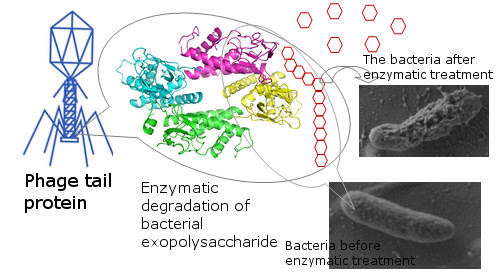Preprint
Article
The Antibiofilm Activity of Dual-Function Tail Tubular Protein B from KP32 Phage
Altmetrics
Downloads
1014
Views
1056
Comments
0
This version is not peer-reviewed
Submitted:
07 May 2018
Posted:
08 May 2018
You are already at the latest version
Alerts
Abstract
Background: Dual function tail tubular proteins (TTP) belonging to the lytic bacteriophages are the interesting group of biologically active enzymes. Surprisingly, apart from their structural function, they are also polysaccharide hydrolyzes destroying bacterial extracellular components. One of the representatives of this group is TTPB from Klebsiella pneumoniae phage – KP32. TTPB hydrolyzes exopolysaccharide (EPS) of Klebsiella pneumoniae and Enterococcus faecalis strain. This depolymerizing feature was associated with the activity to prevent bacterial biofilm formation. TTPB can inhibit biofilm formation by K. pneumoniae, Enterobacter cloacae, Staphylococcus aureus, Enterococcus faecalis and Pseudomonas aeruginosa strains. Moreover, synergistic activity with antibiotic action has been observed, most likely due to depolymerases’ facilitation of contact of antibiotic with bacterial cells. Methods: TTPB was overexpressed in E coli system, purified and tested towards the bacterial strains using agar overlay method. The hydrolytic activity of TTPB was performed using EPSs of K. pneumoniae PCM2713 and E. cloacae ATCC 13047 as the substrates. Next, we determined the reducing sugar (RS) levels in the TTPB/EPS mixtures, regarding the RS amount obtained after acidic hydrolysis. The antibiofilm activity of TTPB has been set down on bacterial biofilm using a biochemical method. Finally, we have demonstrated the synergistic activity of TTPB with kanamycin. Results: For the first time, the hydrolytic activity of TTPB towards bacterial EPSs has been shown. TTPB releases about a half of the whole RS amount of EPSs belonging to K. pneumoniae PCM 2713 and E. cloacae ATCC 13047 strains. 1.12 µM of the phage protein reduces biofilm of both strains by over 60%. Destroying the bacterial biofilm the phage protein improves the antibiotic action increasing kanamycin effectiveness up to four times.

Keywords:
Subject: Biology and Life Sciences - Virology
Copyright: This open access article is published under a Creative Commons CC BY 4.0 license, which permit the free download, distribution, and reuse, provided that the author and preprint are cited in any reuse.
MDPI Initiatives
Important Links
© 2024 MDPI (Basel, Switzerland) unless otherwise stated






